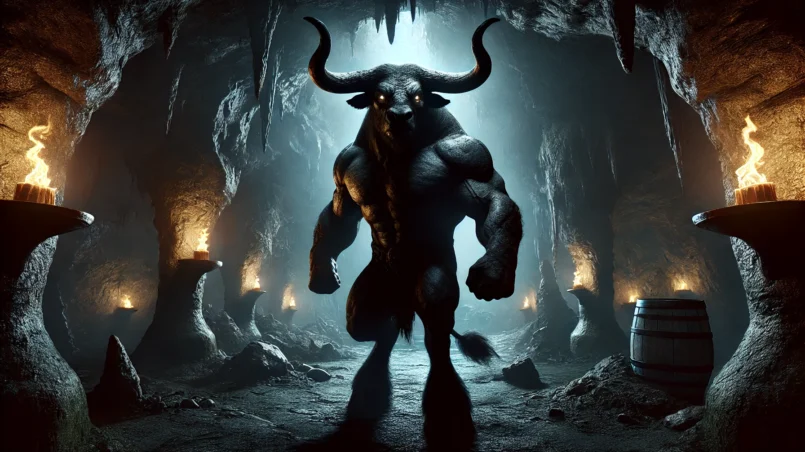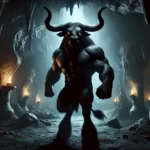Greek mythology is full of fascinating stories, and some of the most memorable ones feature terrifying monsters. These creatures have thrilled people for centuries, becoming key parts of the myths and legends from ancient Greece. Let’s take a look at some of the most famous Greek monsters and the tales that made them legendary.
The Minotaur: The Beast of the Labyrinth
The Minotaur is perhaps one of the most iconic monsters in Greek mythology. With the body of a man and the head of a bull, this creature lived in the Labyrinth on the island of Crete. According to legend, the Minotaur was born from the union of Pasiphaë, the wife of King Minos, and a bull sent by the god Poseidon. King Minos, ashamed of this monstrous offspring, ordered the architect Daedalus to build a vast maze to contain the beast.
Every year, Minos demanded tribute from Athens in the form of young men and women to be sacrificed to the Minotaur. This continued until Theseus, a hero of Athens, volunteered to enter the Labyrinth. With the help of Minos’ daughter, Ariadne, who gave him a ball of thread to navigate the maze, Theseus confronted and defeated the Minotaur, ending its reign of terror.
Medusa: The Gorgon with a Stony Gaze
Medusa is another well-known monster, infamous for her ability to turn anyone who looked directly at her into stone. She was one of the three Gorgons, sisters with snakes for hair and horrifying visages. Unlike her immortal sisters, Medusa was mortal.
Medusa was once a beautiful maiden, but she was transformed into a monster by the goddess Athena as punishment for being seduced by Poseidon in Athena’s temple. Perseus, another famous Greek hero, was tasked with bringing back Medusa’s head. Using a reflective shield given to him by Athena, Perseus avoided Medusa’s deadly gaze and decapitated her. From her blood sprang Pegasus, the winged horse, and Chrysaor, a giant wielding a golden sword.
The Hydra: The Multi-Headed Serpent
The Hydra, a serpent-like creature with multiple heads, terrorized the swamps of Lerna. Each time a head was cut off, two more would grow back in its place, making it a formidable foe. The Hydra’s breath was also poisonous, adding another layer of danger to those who dared to confront it.
Heracles, also known as Hercules, faced the Hydra as one of his Twelve Labors. With the help of his nephew Iolaus, Heracles discovered that he could prevent the heads from regenerating by cauterizing the neck stumps with a burning torch after decapitation. Finally, he buried the immortal head of the Hydra under a massive rock to ensure it could never harm anyone again.
The Chimera: A Fiery Menace
The Chimera is a fearsome creature that is part lion, part goat, and part serpent. It had the body and head of a lion, a goat’s head emerging from its back, and a serpent for a tail. This fire-breathing monster ravaged the lands, causing destruction wherever it went.
Bellerophon, a hero of Greek mythology, was tasked with defeating the Chimera. With the aid of the winged horse Pegasus, Bellerophon was able to fly above the monster, out of reach of its fiery breath. Using a spear tipped with lead, he managed to thrust it into the Chimera’s mouth. The lead melted from the creature’s fiery breath, suffocating it and ending its reign of terror.
The Cyclops: One-Eyed Giants
The Cyclopes were giant beings with a single eye in the middle of their foreheads. The most famous among them was Polyphemus, who appears in Homer’s “Odyssey.” Polyphemus was a shepherd who lived on an isolated island and was known for his strength and brutality.
Odysseus and his men encountered Polyphemus during their journey home from the Trojan War. The Cyclops trapped them in his cave and began to eat them one by one. Odysseus devised a clever plan to escape. He and his men sharpened a large stake and blinded Polyphemus while he slept. The next day, they escaped by hiding under the bellies of Polyphemus’s sheep as they were let out to graze.
The Sirens: Enchanting Singers
The Sirens were mythical creatures known for their enchanting voices. They lured sailors to their doom with their beautiful songs, causing ships to crash on the rocky shores of their island. Depicted as part woman and part bird, the Sirens were dangerous and irresistible.
Odysseus also encountered the Sirens during his travels. Warned of their deadly allure, he had his men plug their ears with beeswax and had himself tied to the mast of his ship. As they sailed past the Sirens, Odysseus was captivated by their song but unable to steer the ship towards them, thus avoiding disaster.
Scylla and Charybdis: Sea Monsters of the Strait
Scylla and Charybdis were two sea monsters that posed a great threat to sailors passing through the narrow Strait of Messina. Scylla was a creature with multiple heads and tentacle-like limbs that snatched sailors from their ships. On the other side of the strait, Charybdis was a massive whirlpool that swallowed ships whole.
Navigating between these two monsters was perilous. In “The Odyssey,” Odysseus chose to sail closer to Scylla, sacrificing a few men rather than risking his entire ship being swallowed by Charybdis. This decision allowed him to continue his journey, though at a great cost.





